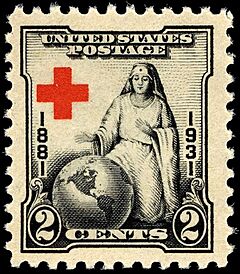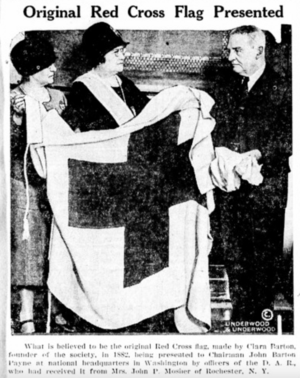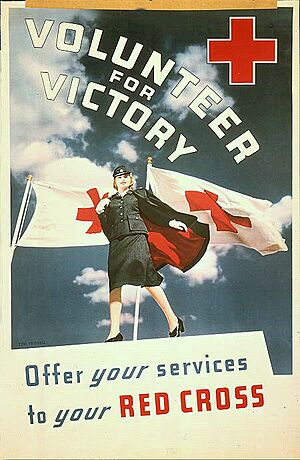American Red Cross facts for kids
 |
|

|
|
| Formation | May 21, 1881 |
|---|---|
| Founder | Clara Barton |
| Type | Charitable organization |
| Legal status | A non-profit organization recognized by the U.S. government |
| Purpose | Humanitarian aid |
| Headquarters | American Red Cross National Headquarters |
| Location |
|
|
Region served
|
United States |
|
Key people
|
|
|
Main organ
|
Board of Governors |
|
Revenue
|
US$3.4 billion (2022) |
The American National Red Cross, often just called the American Red Cross, is a famous non-profit group that helps people in need. A non-profit organization uses its money to help people, not to make money for owners. The Red Cross is a humanitarian organization, which means its goal is to help others and reduce suffering.
It provides emergency help, disaster relief, and teaches people how to be prepared for disasters in the United States. It was founded in 1881 by a brave woman named Clara Barton. She was inspired by the Red Cross movement that started in Geneva, Switzerland. The American Red Cross is part of a global network called the International Red Cross and Red Crescent Movement.
The organization has helped people during many major events, including the sinking of the RMS Titanic in 1912, World War I, World War II, Hurricane Katrina, and the 2023 Hawaii wildfires. It also collects blood donations to help save lives.
History of the American Red Cross
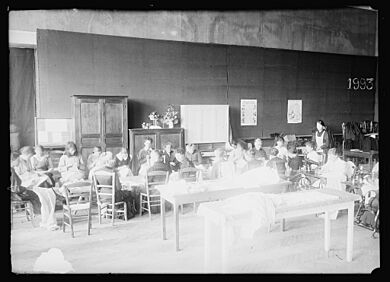
American Red Cross workplace, Memphis TN, c. 1898
|

American Red Cross WWI poster
|
Who Founded the American Red Cross?

Clara Barton started the American Red Cross on May 21, 1881, in Dansville, New York. She was its first president. She learned about the International Red Cross while traveling in Europe. She saw how they helped wounded soldiers during a war and knew that America needed an organization like it.
When she returned home, she worked hard to create the American Red Cross. Her friend, the famous abolitionist Frederick Douglass, gave her advice and support. He also signed the organization's first official papers.
The first local chapter, or group, was started in a church in Dansville in 1881. Later, a national headquarters was built near the White House in Washington, D.C.
Another important founder was Jane Delano, who started the American Red Cross Nursing Service in 1910. This service organized thousands of nurses to help people during disasters and wars.
Early Work and Growth
One of the first major disasters the American Red Cross responded to was the Johnstown Flood in 1889. A dam broke in Pennsylvania, and over 2,200 people died. The Red Cross was there to provide shelter, food, and medical care to the survivors.
After Clara Barton retired in 1904, the organization continued to grow. New leaders helped make it more organized and ready to handle even bigger challenges. When the famous ship RMS Titanic sank in 1912, the Red Cross helped the survivors and the families of those who were lost.
What Does the Red Cross Do Today?
The American Red Cross has five main areas of service. They help people during disasters, support the military, collect blood, provide health and safety training, and do international work.
Disaster Services
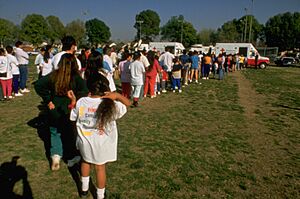
Every year, the American Red Cross responds to more than 60,000 disasters. Most of these are home fires, but they also help during big events like hurricanes, floods, and tornadoes.
When a disaster happens, Red Cross volunteers arrive to help. They open safe shelters, provide warm meals and clean water, and offer health and emotional support to people who have lost everything. Their main goal is to help families get back on their feet.
It's important to know that the Red Cross is not a government agency. However, the U.S. Congress gave it a special mission in 1905 to provide disaster relief. They work with other groups like the Salvation Army to help as many people as possible.
Blood Services
The Red Cross collects about 45% of all the donated blood in the United States. This blood is supplied to hospitals to help patients who are sick or injured. Donating blood is a simple way to save a life.
To make sure the blood is safe, the Red Cross uses modern tests to check for any diseases. They also use a special filtering process to make blood transfusions safer for patients. The organization also does research to find new and better ways to use blood to treat illnesses.
Training Services
The Red Cross also teaches life-saving skills. They offer many classes to the public so that anyone can be prepared to help in an emergency. Some of the most popular courses include:
- First Aid/CPR/AED
- Babysitter's Training
- Lifeguarding
- Learn to Swim
- Wilderness and Remote First Aid
In 2018, the Red Cross started using special manikins (dolls used for training) in their CPR classes. These manikins have lights that show how blood flows to the brain when you do chest compressions correctly. This helps students learn better.
Service to the Armed Forces
The Red Cross has a special mission to help members of the U.S. military and their families. One of their most important services is providing emergency communication. If there's a family emergency at home, the Red Cross can quickly get a message to a service member who is stationed far away.
During World War II, the Red Cross created the Clubmobile Service. Volunteers, often called "Donut Dollies," drove trucks to the front lines to give soldiers coffee, donuts, and a friendly face from home. This service helped boost the spirits of the troops.
International Services
The American Red Cross is part of a worldwide team that helps people in other countries. They work on global health problems, like fighting diseases such as measles.
They also have a special program called Restoring Family Links. This service helps find family members who have been separated by war or disaster. It allows them to send messages to each other and, hopefully, reconnect.
Famous Disaster Responses
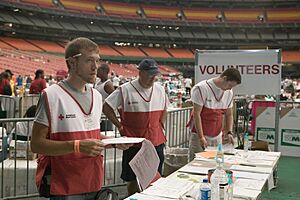
Over its long history, the Red Cross has been there for some of the world's biggest events.
World War I and the 1918 Flu
During World War I, the Red Cross grew enormously. Millions of Americans joined as members or volunteers. The organization sent nurses, ambulances, and supplies to Europe to help soldiers and civilians. When a deadly flu pandemic hit in 1918, Red Cross chapters across the U.S. set up hospitals, sewed masks, and cared for the sick.
World War II
During World War II, the Red Cross was again a huge part of the war effort. Volunteers collected 13.3 million pints of blood for the armed forces. They also prepared 27 million packages with food and supplies for prisoners of war.
Hurricane Katrina (2005)
When Hurricane Katrina hit the Gulf Coast, the Red Cross launched one of its largest responses ever. They opened nearly 1,500 shelters for people who lost their homes. Over 300,000 Red Cross workers, most of them volunteers, provided food, shelter, and financial help to 1.4 million families.
Hawaii Wildfires (2023)
After devastating wildfires on the island of Maui, the Red Cross quickly opened shelters. They worked with local officials to provide thousands of people with a safe place to stay, food, and emotional support during a very difficult time.
Images for kids
See also
 In Spanish: Cruz Roja Americana para niños
In Spanish: Cruz Roja Americana para niños
- American Red Cross Motor Corps
- American Red Cross Volunteer Life Saving Corps


